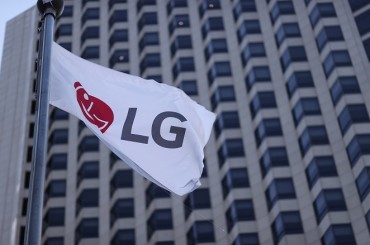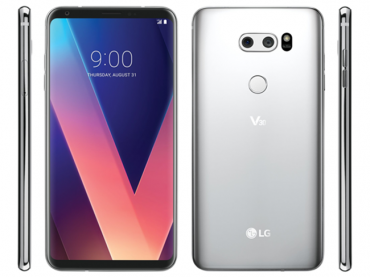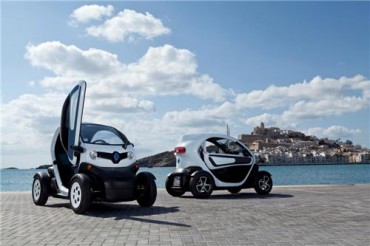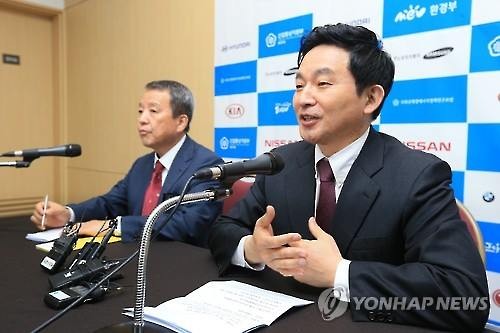
Jeju Governor Won Hee-ryong (R) speaks at a press conference held on March 18, 2016 during the IEVE that kicked off the same day. (Image : Yonhap)
JEJU, March 23 (Korea Bizwire) – Electric vehicles (EVs) are not a thing of the future anymore but a reality, and this is what people might have in mind when they see diverse green car models on display at an expo underway in this island.
Many still could not shake thinking about the fact that there is still a long list of challenges before all-electricity and zero-emission cars become a “real” part of daily life. A lack of infrastructure, relatively short driving distance and high prices are being cited as major drawbacks.
Hundreds of industry leaders, experts, business people and even potential customers gathered on Friday at the third International Electric Vehicle Expo (IEVE) that kicked off for a seven-day run in this southern resort island.
More than 140 automakers, battery makers and other parts producers joined the event. The numbers of participating companies and products on display have nearly doubled, indicating an increased interest in EVs among businesses.
South Korea’s top automaker Hyundai Motor helped boost the festive mood by taking the cover off the Ioniq electric that can run around 180 kilometers on a single charge. Renault Samsung Motors Co. came out with its best selling EV model, the SM3 ZE, while BMW and Nissan also showcased the i3 and the popular Leaf, respectively.
Compared with years back, technology has greatly advanced in design, drivability and batteries. No wonder that some have said that EVs have come closer to daily life, not something reserved for the future anymore.
But the reality is that the EV market is still in its early stage with its sales staying quite small. The latest data shows sales of EVs in South Korea at 3,000 units last year, which accounted for a meager 0.2 percent of total auto sales.
There are many reasons behind the lackluster sales, and what makes many potential customers most hesitant might be its high prices. Though it depends on the model, the Ioniq electric, for example, is priced at over 40 million won.
What helps keep the prices down and affordable now is diverse tax breaks and subsidy programs granted by central and regional governments, a tentative scheme intended to boost the fledgling market. In some cases, they could drive the prices down by half.
Experts are wondering what would happen if the subsidies and other benefits are gone.
“We cannot have this subsidy program forever,” Won Hee-ryong, governor of Jeju Island, said during a press conference held on the sidelines of the IEVE, which will last until Thursday.
“We are looking for ways… to keep customers interested in EVs even after the subsidies are gone. I am not that optimistic that people would buy an EV with little or scaled-back subsidies,” he added.’
Won has been behind Jeju Island’s long-term carbon-free island project under which he pushes to turn all vehicles on the road into EVs by 2030. Under the long-term project, Jeju is ramping up its efforts to build necessary infrastructure and encourage people to opt for green cars through incentives.
“A fundamental issue is how we lower the EV prices and, among other things, how we lower the battery prices that account for a chunk,” he said.
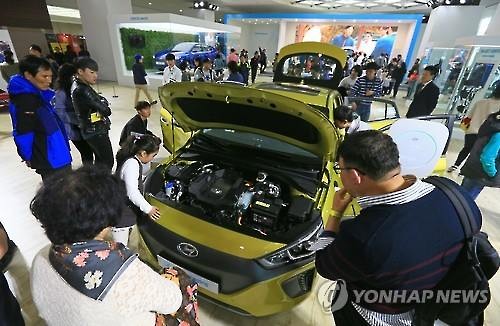
Visitors look at the Ioniq electric on display by Hyundai Motor Co. at the IEVE on March 19, 2016, the second day of the expo. (Image : Yonhap)
Encouraging news is that battery prices, which usually account for 30-40 percent of the costs needed to produce an EV, have dropped significantly in recent years and will continue to decline further down the road in line with growing demand.
An industry report showed that battery prices have fallen to US$180-250 per cell, compared with around $1,000 in 2008. It still remains to be seen how much of the cut would be reflected in price tags for EVs, some experts said.
Besides the cost factor, there are convenience and reliability issues hampering EVs’ takeoff. A lack of charging stations is among them, and another related problem is that if there is one, it takes hours to fully charge an EV.
Making the matter worse, the recent historically low oil prices are also cited as a downside factor that would weaken demand for EVs by chipping away one of the few strong merits of their relatively low maintenance costs.’
“Who would buy an EV when its prices remain too high, maintenance costs are not as cheap as expected, and such a baffling situation can come up where your car can stop in the middle of the road with no charging stations in sight,” an expo participant said on condition of anonymity.
Among all these unfavorable factors, some experts argue that EVs should not be regarded as a matter of money and convenience, but a matter of health and the environment.
“You cannot live with smog,” Kim Dae-hwan, the chairman of the organizing committee for the IEVE, said in a recent interview. “Electric vehicles are synonymous with the environment. This is a general trend that we should go with, and there is no turning back, no matter how cheap the fossil fuel prices would be.”
One bright spot might be that major automakers rush to develop green cars to meet tightened environmental regulations at home and abroad, no matter how unprofitable it may be, and, as a result, customers will likely have more options to choose from.
In its mid-term business blueprint, Hyundai Motor recently said that it will develop a total of 26 environmentally friendly vehicles, including six EVs, by 2020.
Some business people agree that it is important to keep in mind that their profit-seeking nature should not come at the expense of their obligation to hand over a clean environment to the next generation.
“We have an obligation to protect the environment for the next generation. Hyundai Motor will endeavor to maximize the level of customer satisfaction through technological innovations without forgetting the great cause of minimizing environmental damage,” said Yang Woong-cheol, a vice chairman of Hyundai Motor Group, in his keynote speech at the expo on Thursday.
(Yonhap)



